Shedding Some Light on Barbecue Ribs
Barbecue ribs, a quintessential delight of smoke, tenderness, and savory flavors, often spark numerous questions among home cooks eager to perfect this beloved dish. Whether it’s choosing between baby back ribs and spare ribs, debating the merits of dry rubs versus marinades, or deciding on the optimal cooking method—grilling, smoking, or oven-baking—the journey to tender, succulent ribs is filled with culinary inquiries.
One of the first quandaries is selecting the right ribs: do you prefer the leaner, curved baby back ribs or the meatier spare ribs with their rich flavor and satisfying chew? This decision sets the stage for the subsequent steps in preparation and cooking.
Temperature and timing are critical concerns, influencing the ribs’ texture and juiciness. Should the ribs be cooked low and slow for hours to achieve fall-off-the-bone tenderness, or is a hot and fast approach more suitable for a caramelized exterior and a juicy interior?
Flavor enhancement is another puzzle. From choosing the perfect spice rub or marinade to determining the ideal wood chips for smoking, each decision shapes the final taste experience. And of course, the eternal debate over saucing—when to apply it, how much to use, and whether to mop or glaze—adds a layer of complexity to the process.
Mastering barbecue ribs requires navigating these questions creatively and skill, turning each cooking session into an opportunity to craft mouthwatering, finger-licking goodness for friends and family to savor.
Pork Ribs
When it comes to pork ribs, there are several different types that you can get from a pig, each with unique characteristics and cooking methods. Here are the main types:
- Baby Back Ribs: These ribs come from the upper part of the ribcage, near the spine. They are smaller, more tender, and leaner than other ribs. Baby back ribs are curved and usually have a small amount of meat both between and on top of the bones.
- Spare Ribs: Cut from the belly of the pig after the belly is removed; spare ribs are larger, meatier, and have more fat than baby back ribs. They also have a flatter shape and are often less expensive. Spare ribs are often preferred for their richer flavor and slightly tougher texture.
- St. Louis-Style Ribs: These spare ribs have been trimmed down to a more uniform rectangular shape by removing the cartilage, breastbone, and rib tips. This cut offers a meatier and more aesthetically pleasing presentation, making them popular for competition barbecue.
- Rib Tips: These are the small, meaty pieces that are cut away when preparing St. Louis-style ribs. They are flavorful and have a mix of meat, cartilage, and fat. They are often grilled or smoked separately.
- Country-Style Ribs: These are not ribs but are cut from the blade end of the loin near the shoulder. They are meatier than other rib cuts and can be boneless or bone-in. Country-style ribs are versatile and can be grilled, baked, or braised.
- Riblets: Riblets are made by cutting a full rack of ribs into smaller pieces, usually in half lengthwise. They are often sold as smaller, individual pieces, making them easier to handle and cook.
Each rib type offers a different flavor, texture, and cooking experience, allowing home cooks to choose based on their preferences and desired preparation methods.
Beef Ribs
When it comes to beef ribs, there are several distinct types that you can get from a cow, each offering unique flavors and textures. Here are the main types:
- Back Ribs: Also known as beef back ribs, these are cut from the upper part of the cow’s ribcage, near the spine, and beneath the loin muscle. They are the ribs left over when the boneless ribeye steaks or ribeye roasts are removed. Back ribs have less meat than other types but are prized for their rich, beefy flavor.
- Short Ribs: These are cut from the lower part of the cow’s ribcage, near the breastbone, and can come from different sections such as the chuck or the plate. Short ribs are known for their meaty and marbled texture, which makes them ideal for slow-cooking methods like braising or smoking. There are two main types of short ribs:
English-Cut Short Ribs: These are cut parallel to the bone, resulting in a thick piece of meat sitting on top of one bone. They are often used in braising or slow-cooking recipes.
Flanken-Cut Short Ribs: These are cut across the bones, resulting in thin strips of meat with multiple small cross-sections of bone. This cut is popular in Korean barbecue (known as “galbi”) and is typically grilled or braised.
- Plate Ribs: Also known as beef plate short ribs, plate ribs come from the plate primal near the cow’s belly. They are larger and meatier than back ribs, with a good amount of fat and connective tissue, making them ideal for smoking or slow-cooking. Plate ribs are often used in Texas-style barbecue.
- Chuck Short Ribs: These ribs come from the chuck primal, near the shoulder. They are smaller than plate ribs but still have a substantial amount of meat and fat. Chuck short ribs are versatile and can be grilled, braised, or slow-cooked.
- Ribeye Cap Ribs: These specialty cuts include the ribeye cap (spinalis dorsi) attached to the rib bone. The ribeye cap is a highly marbled, flavorful meat often grilled or roasted.
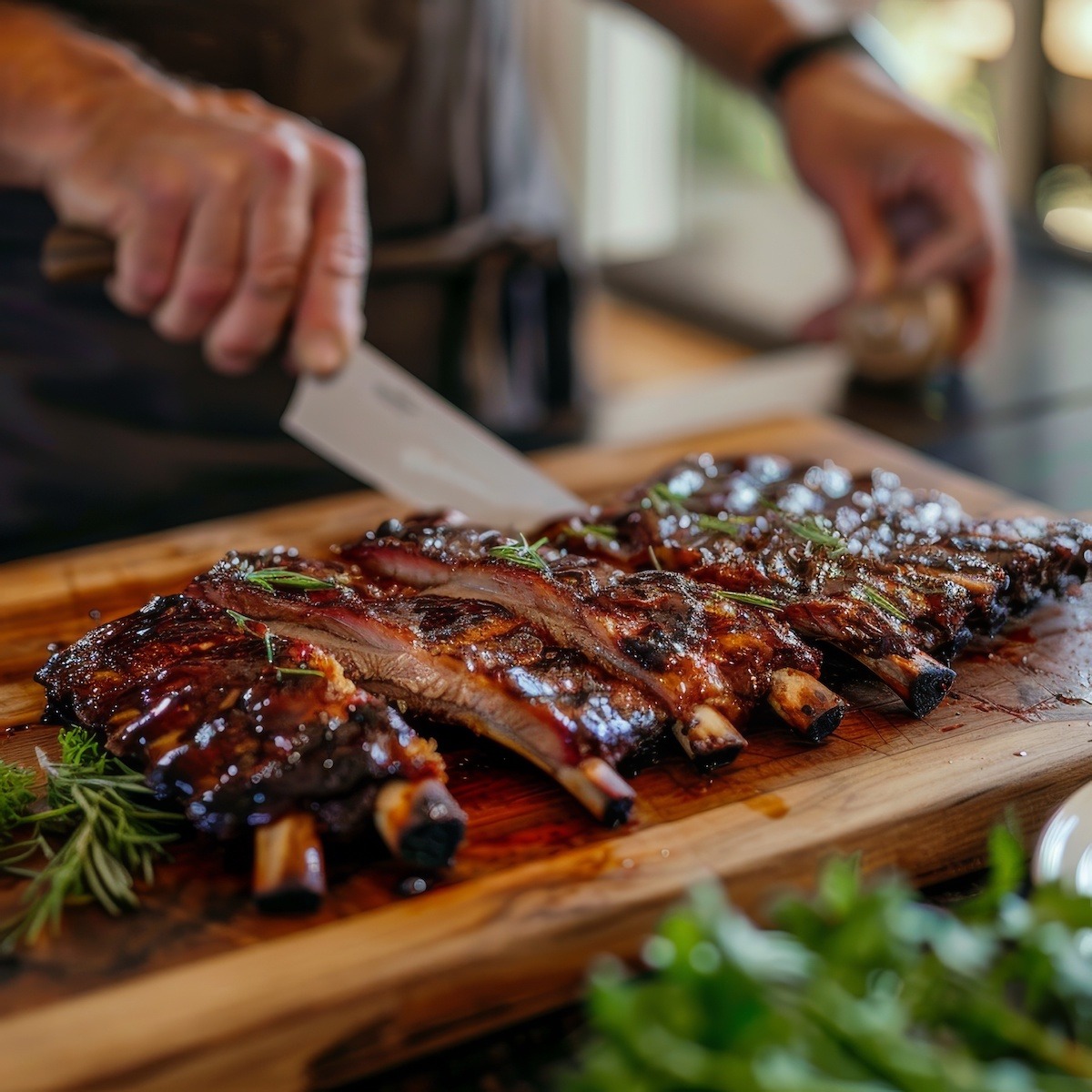
But ribs are ribs, right? They probably all taste the same.
This is false. Each rib type from pigs and cows has its unique flavor profile, texture, and fat content, which can significantly affect the taste and cooking method. Here’s a brief overview of the differences:
Pork Ribs:
- Baby Back Ribs: These are tender and lean, with a slightly milder flavor than other pork ribs. They often have a subtle sweetness and are typically more tender than spare ribs.
- Spare Ribs: These are meatier and have a richer, more robust flavor due to the higher fat content. The meat is slightly tougher but becomes very tender when cooked properly.
- St. Louis-Style Ribs: These have a similar flavor to spare ribs but with a more uniform shape. They are also rich and flavorful, with a good balance of meat and fat.
- Rib Tips: These are flavorful and chewy, mixing meat, cartilage, and fat. They have an intense pork flavor and are often very tender when cooked slowly.
- Country-Style Ribs: These are the meatiest pork ribs and can be very flavorful, especially when cooked low and slow. They are less fatty and more like a pork chop in texture.
- Riblets: Their flavor can vary depending on how they are cut, but they generally offer a rich, porky taste similar to spare ribs.
Beef Ribs:
- Back Ribs: These have a rich, beefy flavor but less meat than other beef ribs. The meat is tender and flavorful, especially when slow-cooked or smoked.
- Short Ribs: These are flavorful due to their high-fat content and marbling. They have a rich, beefy taste and a tender, succulent texture when braised or slow-cooked. The English cut provides large, meaty portions, while the flanker cut has a good mix of meat and bone.
- Plate Ribs: These are some of the meatiest and most flavorful beef ribs, with a rich, hearty taste. They have much connective tissue that breaks down during slow cooking, making them extremely tender.
- Chuck Short Ribs: These have a robust, beefy flavor and are slightly fattier, making them very flavorful and ideal for braising or slow-cooking.
- Ribeye Cap Ribs: These are highly prized for their intense marbling and rich, buttery flavor. The meat is very tender and flavorful, making it a premium choice for grilling or roasting.
Factors Affecting Flavor:
- Fat Content: Higher fat content generally means more flavor and a juicier texture.
- Marbling: The distribution of fat within the muscle affects tenderness and flavor.
- Bone-In vs. Boneless: Bones can add flavor to the meat during cooking.
- Cooking Method: Smoking, grilling, braising, and slow cooking can all impart different flavors and textures to the ribs.
- Seasoning and Marinades: Rubs, marinades, and sauces can greatly influence the final taste of ribs.
How Many Ways Are There To Cooking Ribs?
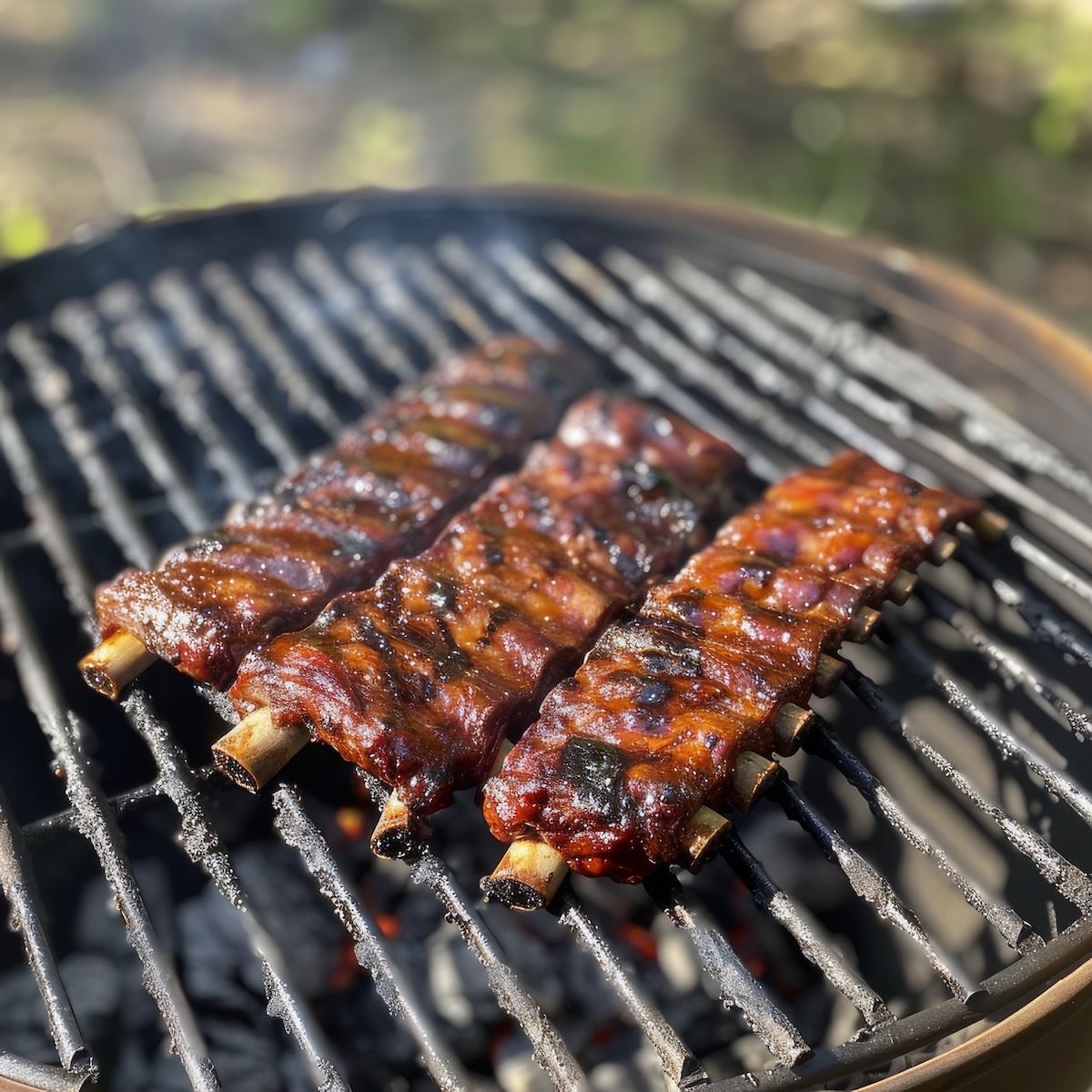
There are several methods to cook ribs, each offering a unique flavor and texture. Here are the various ways you can cook ribs:
- Grilling:
- Direct Grilling involves cooking ribs directly over the heat source. This method is faster but requires careful attention to avoid burning.
- Indirect Grilling involves cooking ribs next to, not directly over, the heat source. This method allows for slower cooking and better control over doneness.
- Smoker Box: Using a smoker box on a gas grill adds a smoky flavor to the ribs.
- Smoking:
- Traditional Smoker: This method involves using a dedicated smoker to cook ribs slowly over low heat with wood chips or chunks for smoke flavor. It can take several hours but results in tender, flavorful ribs.
- Electric or Pellet Smoker: An electric or pellet smoker maintains a consistent temperature, is easier to use than a traditional smoker, and provides great smoke flavor.
- Baking:
- Oven-Baked: Cooking ribs in the oven at a low temperature. Wrapping the ribs in foil or placing them in a covered pan helps retain moisture.
- Broiling: Finish oven-baked ribs under the broiler for a few minutes to add a crispy, caramelized crust.
- Slow Cooking:
- Crockpot/Slow Cooker: Cooking ribs on low heat for several hours in a slow cooker. This method is convenient and produces very tender ribs.
- Sous Vide: Cooking ribs in a vacuum-sealed bag in a water bath at a precise temperature for an extended period, then finishing on the grill or broiler for a crispy exterior.
- Pressure Cooking:
- Instant Pot/Pressure Cooker: This method cooks ribs quickly under high pressure. It can produce tender ribs in a fraction of the time compared to traditional methods.
- Braising:
- Stovetop/Oven Braising: First, the ribs are seared, then cooked slowly in a flavorful liquid in a covered pot, either on the stovetop or in the oven. This method results in very tender, flavorful ribs.
- Rotisserie:
- Rotisserie Grill: Ribs are cooked on a rotisserie spit over indirect heat. The constant rotation helps cook the ribs evenly and keeps them moist.
- Steaming:
- Steaming Basket: Cook ribs over simmering water in a steaming basket. This method helps tenderize the ribs before finishing them on the grill or under the broiler.
Each cooking method creates different flavors and textures in the ribs, allowing for various delicious results.
Removing the Silver Skin
You should remove the tough membrane, also known as the silver skin, that runs along the length of the bony side of your rack of ribs. Here’s why:
- Improved Tenderness: The membrane is tough and chewy, which can make the ribs less enjoyable to eat. Removing it helps make the ribs more tender and easier to eat.
- Better Flavor Penetration: Removing the membrane allows rubs, marinades, and smoke to penetrate the meat more effectively, enhancing the overall flavor of the ribs.
- Even Cooking: Without the membrane, the ribs cook more evenly as the heat can reach all sides of the meat.
How to Remove the Membrane:
- Start at a Corner: Use a knife to lift a corner of the membrane at one end of the rack.
- Get a Grip: Once you have a corner lifted, use a paper towel to grip the membrane better.
- Peel Away: Gently but firmly pull the membrane off the ribs. It should come off in one piece, but lift and pull off the remaining sections if it tears.
Removing the membrane is a simple step that can significantly improve the texture and flavor of your ribs, leading to a more enjoyable eating experience.
What About Rubs and Mops?
Rubs and mops are essential in the barbecue process, especially for ribs, as they add layers of flavor and help create a delicious crust or bark on the meat. Here’s a detailed look at each:
Rubs:
A rub is a mixture of spices and herbs applied to the surface of meat before cooking. Rubs can be dry or wet and are essential for seasoning and flavoring the meat.
Types of Rubs:
- Dry Rubs:
- Basic Components: Typically include salt, sugar (brown sugar is popular), and a blend of spices like paprika, black pepper, garlic powder, onion powder, cayenne pepper, cumin, and chili powder.
- Application: Generously sprinkle the dry rub over the ribs and pat it into the meat. For best results, let the rubbed ribs sit for at least an hour or overnight in the refrigerator to allow the flavors to penetrate.
- Wet Rubs:
- Basic Components: Combine dry spices with a liquid component like oil, mustard, Worcestershire sauce, or vinegar to create a paste.
- Application: Spread the wet rub evenly over the ribs. Like dry rubs, letting the ribs marinate for some time enhances the flavor.
Mops:
A mop, also known as a mop sauce, is a thin, often vinegar-based liquid applied to the meat during cooking. Mops help keep the meat moist and add additional layers of flavor.
Types of Mops:
- Vinegar-Based Mops:
- Components: These typically include vinegar, water, or stock, and seasonings like salt, pepper, sugar, and spices.
- Usage: Tangy vinegar is common in Carolina-style barbecue, where it helps tenderize the meat and cut through the richness.
- Beer-Based Mops:
- Components: Often include beer, along with additional flavors like Worcestershire sauce, mustard, and spices.
- Usage: Adds a unique flavor and can help caramelize the meat’s surface.
- Apple Juice-Based Mops:
- Components: Apple juice, sometimes mixed with vinegar or cider, and spices.
- Usage: Adds sweetness and moisture, commonly used in pork barbecue.
How to Use Rubs and Mops:
- Applying Rubs: Apply rubs before cooking. Let the meat marinate for a few hours or overnight for best results.
- Applying Mops: Mop the meat periodically during cooking, typically every 30-60 minutes. Use a brush or a mop tool designed for barbecue. Be careful not to mop too often or too much liquid, as it can wash away the rub.
Tips:
- Balance Flavors: Consider the balance of sweet, savory, and spicy elements in rubs and mops.
- Experiment: Feel free to experiment with different spices and liquids to find your preferred flavor profile.
- Don’t Overdo It: While rubs and mops add flavor, it’s important not to overdo them. Too much rub can make the ribs overly salty, and too much mopping can wash off the rub and make the ribs soggy.
Rubs and mops are fundamental to achieving delicious, flavorful ribs with a perfect crust and moist interior. Experimenting with different combinations can lead to discovering your signature barbecue style.
Smoke and Grill
Professional pitmasters typically use one primary method depending on their desired outcome and personal style, but both smoking only and a combination of smoking and grilling (also known as finishing on the grill) are used in professional barbecue.
Smoking Only:
- Method: The ribs are cooked entirely in a smoker at low temperatures (typically between 225-250°F) for an extended period, often 4-6 hours or more, depending on the cut and size of the ribs.
- Benefits: This method allows the ribs to absorb a deep, smoky flavor throughout cooking, resulting in very tender meat. The low and slow cooking method also helps break down connective tissues and render fat.
- Drawbacks: It requires a longer cooking time and constant temperature monitoring.
Smoking and Then Grilling:
- Method: The ribs are first smoked for several hours to impart the smoky flavor. After smoking, they are finished on a hot grill for a short period (typically 5-15 minutes) to caramelize the exterior and add a slightly crispy texture.
- Benefits: This method combines the best of both worlds—the deep, smoky flavor from the smoking process and the caramelized, slightly charred exterior from the grilling process. The final grilling phase is relatively quick, slightly speeding up the cooking time.
- Drawbacks: If not carefully monitored, the ribs may overcook or dry out during grilling.
Considerations for Both Methods:
- Flavor Profile: Smoking only results in a more consistent smoky flavor, while smoking and then grilling adds a layer of charred, caramelized flavor.
- Texture: Smoking only tends to produce very tender, melt-in-your-mouth ribs. Smoking and grilling can add a pleasant, slightly crispy exterior.
- Time and Effort: Smoking only requires longer cooking time but less active management, while the combination method requires careful attention during the final grilling phase to avoid overcooking.
- Equipment: Smoking only requires a smoker and consistent temperature control, while the combination method requires both a smoker and a grill.
Pro Tips:
- Consistency: Professional pitmasters often stick to one method to ensure consistent results, especially in competitions where precision is key.
- Resting Time: Regardless of the method, letting the ribs rest for a few minutes after cooking helps redistribute the juices and enhances tenderness.
- Experimentation: Many pros experiment with both methods and adjust based on the specific cut of ribs, the desired flavor profile, and the equipment available.
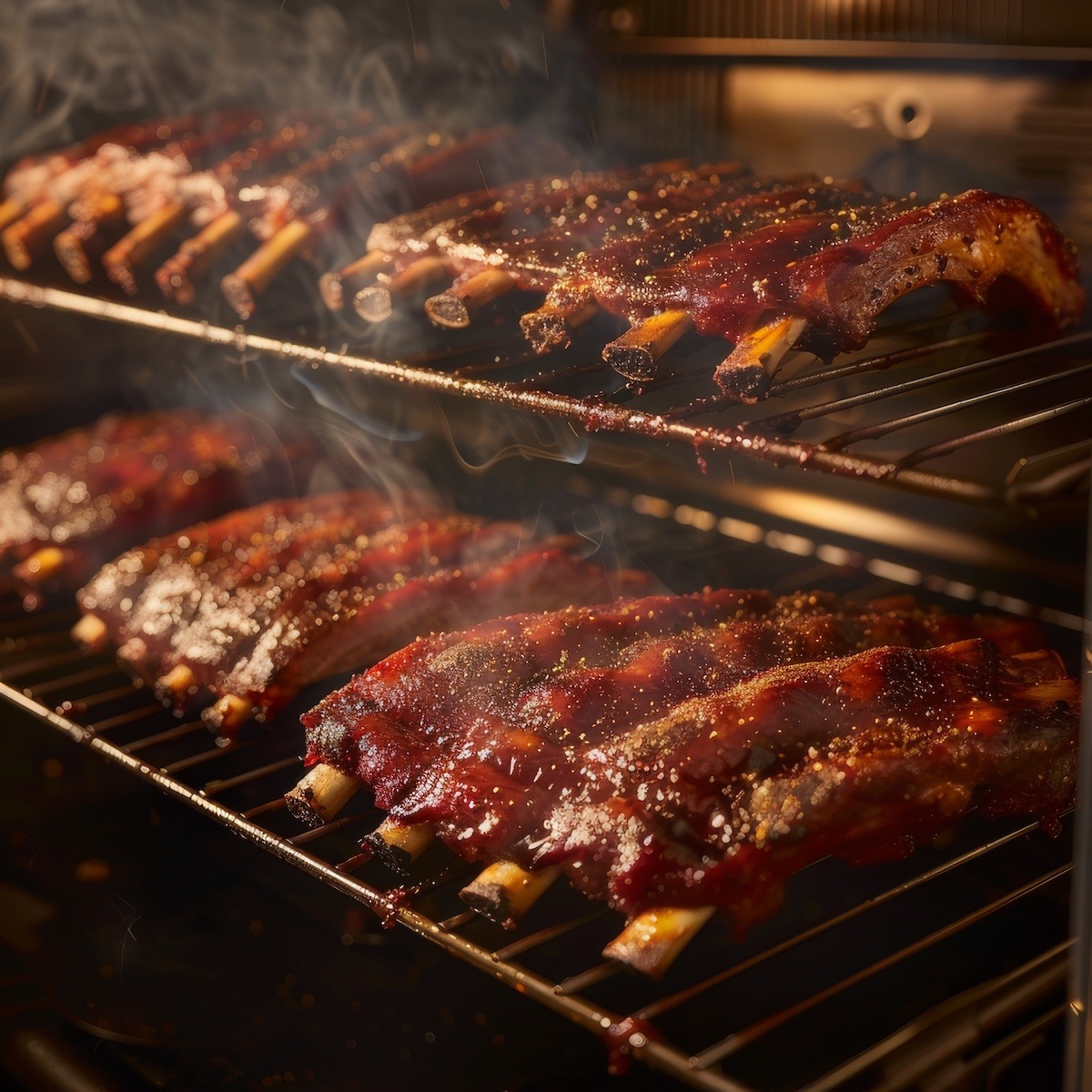
The 3-2-1 Method
The 3-2-1 method is a popular technique for smoking pork ribs, particularly spare ribs, to achieve tender, flavorful, and juicy results. This method breaks down the smoking process into three distinct stages over a total of six hours. Here’s a detailed explanation:
The 3-2-1 Method:
- 3 Hours of Smoking (Unwrapped)
- Preparation: Start by preparing your ribs. Remove the membrane from the back of the ribs, generously apply your favorite dry rub, and let the ribs sit for at least an hour (or overnight) to absorb the flavors.
- Smoking: Preheat your smoker to 225°F (107°C). Place the ribs bone-side down on the smoker grates. Smoke the ribs for 3 hours without wrapping them in foil. During this time, the ribs will absorb the smoky flavor and develop a nice bark (the crusty exterior).
- 2 Hours of Cooking (Wrapped)
- Wrapping: After 3 hours, remove the ribs from the smoker. Wrap each rack tightly in aluminum foil to help steam and tenderize the meat. Add a liquid (such as apple juice, beer, or a mix of honey and butter) inside the foil for additional moisture and flavor.
- Cooking: Return the wrapped ribs to the smoker and cook for 2 hours at 225°F (107°C). This stage helps to break down connective tissues and makes the ribs more tender.
- 1 Hour of Finishing (Unwrapped)
- Unwrapping: After 2 hours, carefully remove the ribs from the foil and place them back on the smoker grates, bone-side down.
- Finishing: Smoke the ribs for an additional hour at 225°F (107°C). You can apply barbecue sauce to the ribs during this final stage to create a glaze. Brush the sauce on both sides of the ribs during the last 30 minutes of cooking, allowing it to set and caramelize.
Benefits of the 3-2-1 Method:
- Tenderness: The wrapping stage helps steam the ribs, making them extremely tender and moist.
- Flavor: The initial smoking stage infuses the meat with a rich, smoky flavor, while the final unwrapped stage allows the sauce to caramelize and the bark to firm up.
- Consistency: This method provides a structured timeline that helps ensure consistent results every time.
Tips for Success:
- Monitor Temperature: Keep a close eye on the smoker’s temperature to maintain a consistent 225°F (107°C).
- Quality Wood: To enhance the flavor, use quality smoking wood, such as apple, cherry, hickory, or mesquite.
- Adjust for Rib Type: While the 3-2-1 method is ideal for spare ribs, baby back ribs may require a slightly shorter cooking time, often adjusted to a 2-2-1 method.
The 3-2-1 method is a reliable and straightforward technique for smoking ribs, especially for those new to smoking. It provides clear stages and times to follow, resulting in deliciously tender and flavorful ribs.
What If I Don’t Have a Smoker?
If you don’t have a smoker, you can still achieve delicious, smoky ribs using alternative methods. Here are some options:
Using a Grill (Charcoal or Gas):
You can convert your grill into a smoker by using indirect heat and adding wood chips for smoke.
Charcoal Grill:
- Setup: Arrange the coals on one side of the grill to create a two-zone fire. Place a drip pan with water on the opposite side.
- Wood Chips: Soak wood chips in water for 30 minutes, then place them on the hot coals to create smoke.
- Cooking: Place the ribs on the grill over the drip pan (indirect heat side). Close the lid and maintain a temperature of around 225°F (107°C). Add more coals and wood chips as needed to maintain temperature and smoke.
Gas Grill:
- Setup: Preheat the grill and turn off the burners on one side to create indirect heat.
- Wood Chips: Soak wood chips and place them in a smoker box or wrap them in aluminum foil with holes poked in it. Place the box or foil pouch over the lit burners.
- Cooking: Place the ribs on the unlit side of the grill (indirect heat). Close the lid and maintain a temperature of around 225°F (107°C). Add more wood chips as needed for continuous smoke.
But I Don’t Have Time for All That
Six hours is a huge time commitment. And making your own smoker might seem like growing your own mustard plants so you can make some Dijon to go on your ham! Granted, you don’t need to be standing right over the smoker the whole time, and your neighbors will spend most of the day salivating over the amazing smells coming from your backyard, but as much as I like to do things the authentic way, sometimes I just don’t have the time. So then what?
Oven Method:
While you won’t get the same smoky flavor as a grill or smoker, you can still make delicious ribs in the oven.
Oven-Baked Ribs:
- Preparation: Preheat your oven to 275°F (135°C). Remove the membrane from the ribs and apply your dry rub.
- Cooking: Place the ribs on a baking sheet lined with aluminum foil or in a roasting pan. Cover the ribs tightly with foil.
- Baking: Cook the ribs in the oven for 2.5 to 3 hours until tender.
- Finishing: Remove the foil and brush the ribs with barbecue sauce for a caramelized exterior. Broil them for a few minutes until the sauce is bubbly and slightly charred.
Crock Pot Ribs
A slow cooker can produce very tender ribs, although they won’t have a smoky flavor.
Slow Cooker Ribs:
- Preparation: Remove the membrane from the ribs and apply your dry rub. If needed, cut the ribs into sections to fit in the slow cooker.
- Cooking: Place the ribs in the slow cooker with a small amount of liquid (such as apple juice, broth, or a mixture of barbecue sauce and water).
- Slow Cooking: Cook on low for 6-8 hours or high for 3-4 hours until tender.
- Finishing: To achieve a caramelized exterior, transfer the ribs to a baking sheet, brush them with barbecue sauce, and broil them for a few minutes.
Bert’s Barbecue Baby Back Ribs
Purists would say Bert’s method isn’t barbecue, but this is a great alternative if you are in a hurry and want some delicious steamed/grilled ribs. I have made these ribs many times on weeknights when I don’t have 3 hours to slow cook with smoke.
In Bert’s method, ribs are seasoned and cooked, covered with the contents of a beer bottle. In the past, I have said they are braised, but looking at it more closely, I would say the ribs are steamed and not braised because of the amount of liquid used in the cooking process. To read my post on this process, check out Bert’s Barbecue Baby Back Ribs.

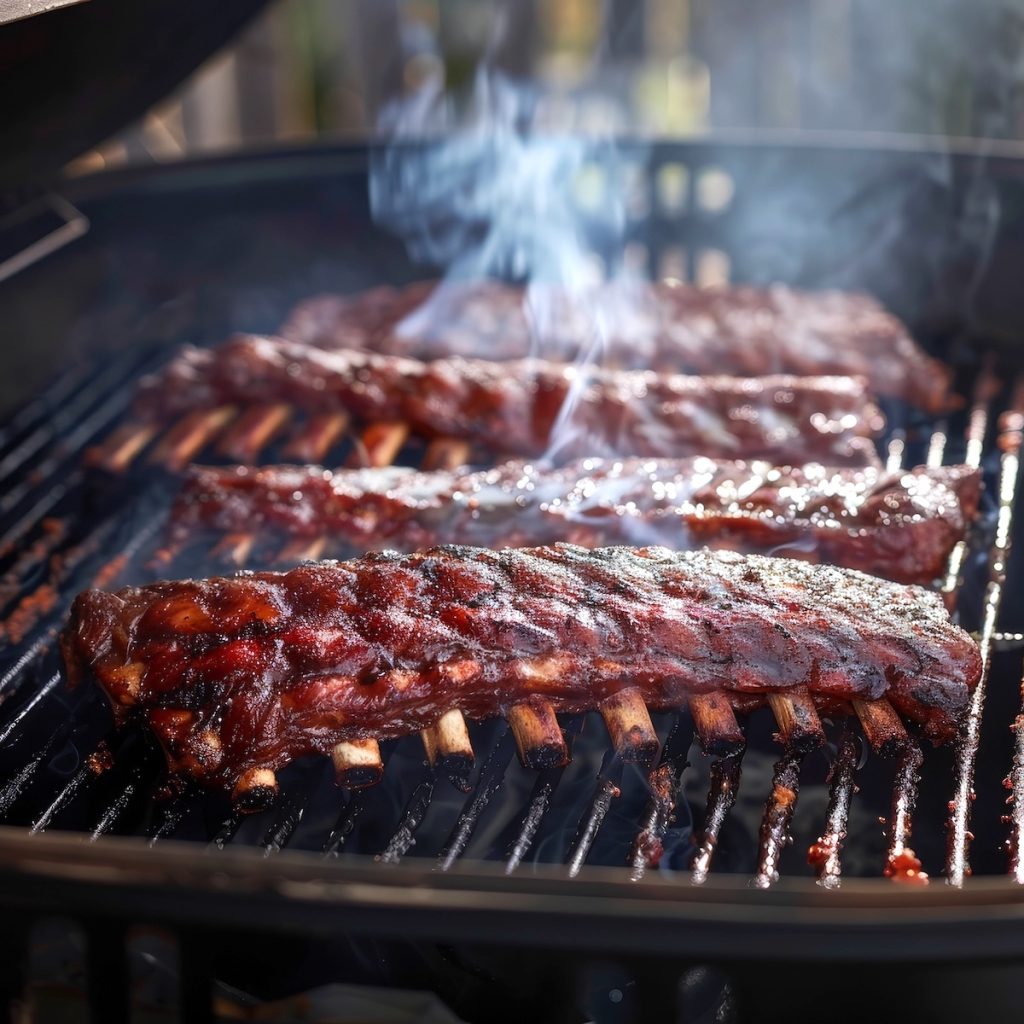
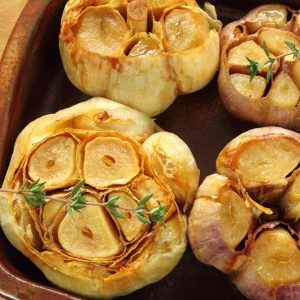
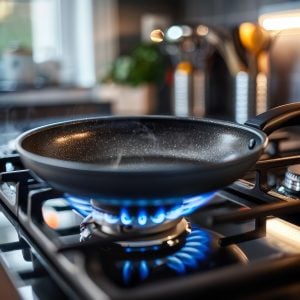
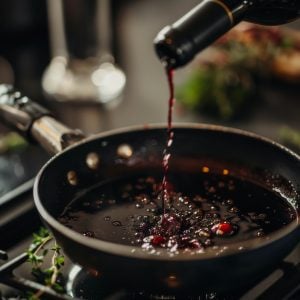
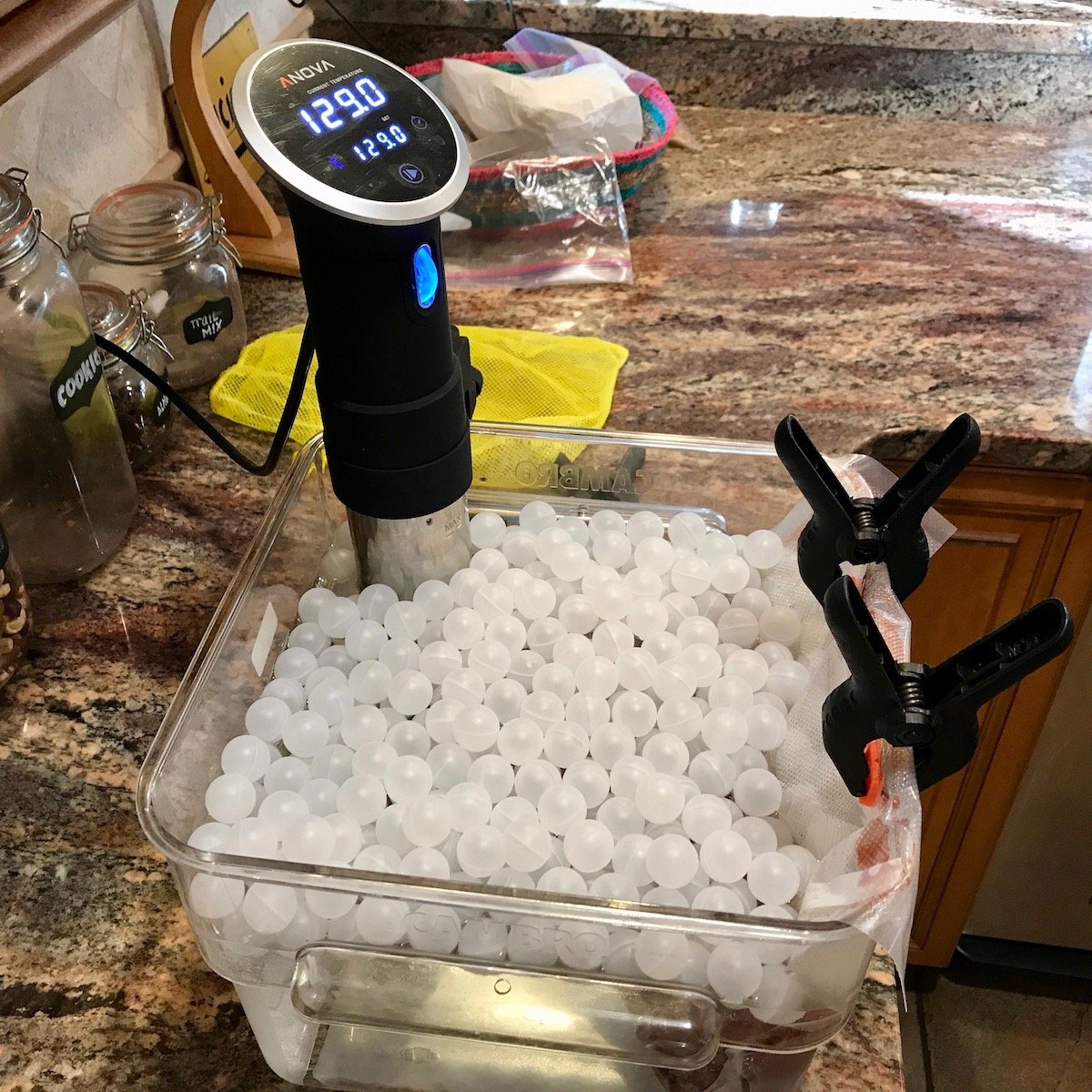
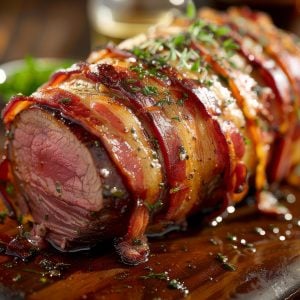

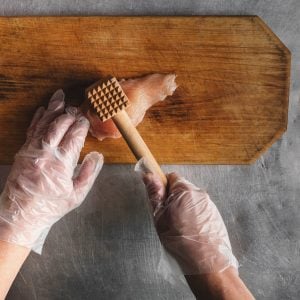

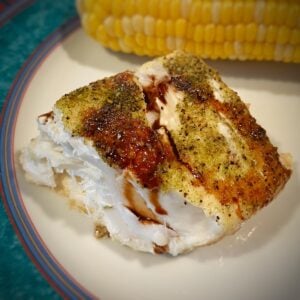


4 Responses
Everything we needed to know about ribs,but were afraid to ask I like a dry rib and here is the recipe for my dry rub.
WENDELL’S DRY RUB
4 Teaspoons Hungarian Paprika
1 Teaspoon Salt
2 Teaspoons Onion Powder
1 Teaspoon Garlic Powder
2 Teaspoons Black Pepper
1 Teaspoons White Pepper
1 1/2 Teaspoons Dry Mustard
1 1/2 Teaspoons Granulated Brown Sugar
Add all ingredients to a 16 ounce jar with a lid. Close lid and shake well until all ingredients are well blended. If for some reason you use regular Brown Sugar, rather that the Granulated type, make sure that it is broken up and it is mixed well with the other ingredients. Stored in a lidded glass container for several weeks at room temperature.
Thanks LADawg, looks good.
Another alternative prep time saver is to put the ribs in a pressure cooker with a bit of beer for 40 minutes or so, then finish them on the grill. Tender and tasty.
The egg-shaped ceramic grill is safe, from the lid all the way to the smoke.
I highly suggest this unique and powerful Napoleon Prestige Gas
Grill for all consumers. As for smoking salmon at home, it’s really not that difficult.